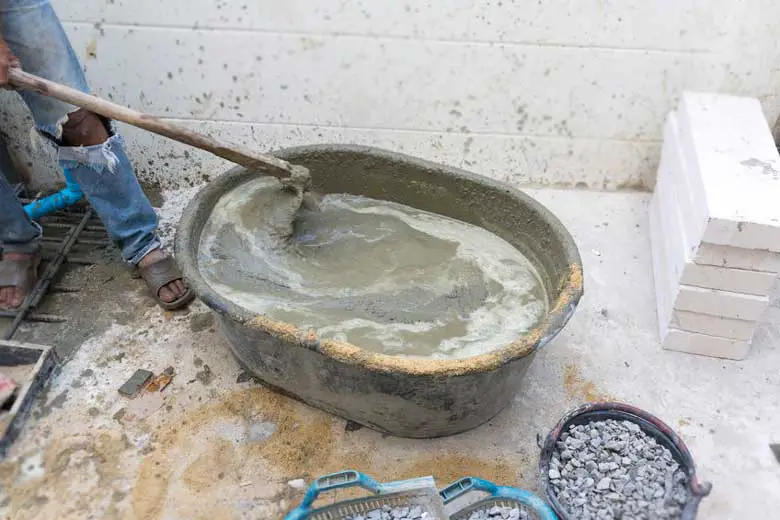Construction concrete should not be too wet, and if yours is sent in such a condition, it would be best to reject the load. However, if you do not accept the supply, you will have to wait a while before a proper one arrives at your job site or home — not productive and time wasteful. Contractors often avoid working in downpours because they do not want their concrete to get soaked.
When concrete gets too wet, the concrete becomes weak and is prone to breakage. Concrete must neither be too dry nor too wet to perform at its best. You want to keep your concrete moist to help the curing process.
It is crucial to understand how concrete works and how your concrete condition can affect your project quality. We will discuss concrete basics, what happens when concrete is too wet, and how you can avoid this situation.

Table of Contents
Understand How Concrete Works
Concrete is a widely-used artificial building material typically made of cement, water, air, sand, and gravel. Concrete usually contains 10% of cement, 20% of water and air, 30% of sand, and 40% gravel, although the proportions may be different in different cement types.
All these ingredients are essential in producing strong concrete, and the quality of your concrete depends heavily on the ingredients and consistency.
Cement
Cement only makes up a small percentage of concrete, but that does not mean it is not as important as the other ingredients in the mixture.
Cement acts as the glue that keeps everything together when the mix hardens.
There are different cement types, with type I (for residential work) and II (for moderate sulfate conditions) commonly used in constructions within the United States.
Read more: Is Cement Stronger Than Concrete?
Air and Water
Air and water must be present in the mixture to ensure the concrete’s effectiveness. Tiny, microscopic air bubbles in the concrete enable excess water to expand when it moves through the freeze-thaw cycle.
Water plays an essential role in concrete because the more water added into a mixture, the less strength a hardened mixture will have.
When concrete gets too wet, the excess water will evaporate and escape the hardened concrete, causing the concrete to shrink and crack.
When preparing your mixture, measure the water to your cement ratio. You can do a slump test to check if your mix is too wet or not.
Gravel and Sand
Gravel and sand make up many concrete proportions, which is good as they provide consumers with a more economical option. Sand and gravel are more robust than cement. Large gravels are used with small sand to make the ideal concrete.
Sand is essential because it can fill the gaps that air pockets could otherwise fill. The sand and gravel also limit shrinkage in concrete when it cures.
Just as you would balance the water and air proportions, you should do the same with sand and gravel.
When Concrete Gets Too Wet
As discussed earlier, when concrete is too wet, the excess water will evaporate and escape the hardened concrete, causing the concrete to crack and eventually break.
You can tell whether your concrete is too wet using the slump test that identifies various shapes: true slump, shear slump, or collapse slump. If you get a collapse slump, it means that your mixture is too wet.
When your mix is too wet, the strength of your dried concrete is reduced. Every additional inch of a slump in the concrete typically reduces the final product’s comprehensive strength by about 500 psi.
In time, the strength will degrade and escalate quickly, causing your structure to be short-lived.
It is essential that you mix your concrete batch the same way if you are working on a concrete project that uses more than one mix or load. You do not want one batch to be more watered down than the rest, as this will show clearly on the final product.
If your concrete is watered down, you may have to throw out your entire batch of concrete, which is frustrating, but the correct mix is vital to your project’s success.
Concrete is porous, which means it will release water through evaporation. When you have too much water in your concrete, the water will increase the porosity, which causes degradation of durability and structural performance.
Porosity can impact any finish or color you want to apply to the surface.
Mixing concrete is not an easy job, especially for DIY construction newbies. To get the right mix, you need to have the proper knowledge, practice, and skill.
If you are not sure how to do it yourself, it would be best to have a reliable batch of ready-mix sent to you instead of mixing it yourself.
Read more: How to Mix Concrete the Right Way
Concrete Bleeding
You might have noticed water appearing on new concrete surfaces and wondered what that was all about. When water comes out from the surface of concrete, that is known as concrete bleeding.
Concrete bleeding happens when free water in the mix moves up to the surface because heavier solid particles such as cement and water settle.
While it is normal for some bleeding to occur, excessive bleeding is a sign of a structural problem.
As you already know, concrete contains cement, air, water, sand, and gravel. The lightest ingredient in the mix is water.
That said, ingredients like gravel, sand, and cement will sink to the bottom of the water. It is therefore natural for water to bleed when you pour your concrete.
After pouring your cement, you want to avoid troweling the bleed water into the cement because you will dilute the cement at the top of the concrete — your concrete slab will eventually peel off in cold temperatures.
Estimating Water Cement Ratio for Concrete
If you notice that your concrete is very hard, you will add water to it in order to increase the concrete workability. However, you might not know exactly how much water you should add to your concrete, especially if you are new to construction.
With the right amount of water-cement ratio to your concrete, you can get strong concrete for your DIY project.
First, you have to understand the concept of a water-cement ratio. A water-cement ratio is a ratio between the water’s weight to the cement’s weight used in a concrete mix.
23% of water is needed to initiate the chemical process on cement.
The water-cement ratio varies from 0.4 and 0.7, depending on the exposure conditions. The formula you use for calculating the required amount of water for quantity is:
The required amount of water = Water-Cement Ratio x Cement volume
Suppose the required cement volume is 50 kg (110.231 lbs) and the water-cement ratio is 0.5, then the quantity of the water will be:
0.5 x 50 kg (1.10 x 110.23 lbs) = 25 liters (845.35 ounces) per 50 kg (110.23 lbs) bag of cement
For design mix, the water-cement ratio will depend on the workability and strength requirements.
Final Thoughts
You must check your concrete mix before working on your project. If the concrete is too wet, this can cause concrete problems in the future.
You must avoid having concrete that’s too dry or too wet.
Concrete that is too wet will have excess water that will evaporate and escape when the concrete hardens, which then causes the concrete to crack and eventually break in the long run. Never trowel bleed water back into the cement if you see it coming out from your concrete. Always check your water-cement ratio carefully before mixing.



